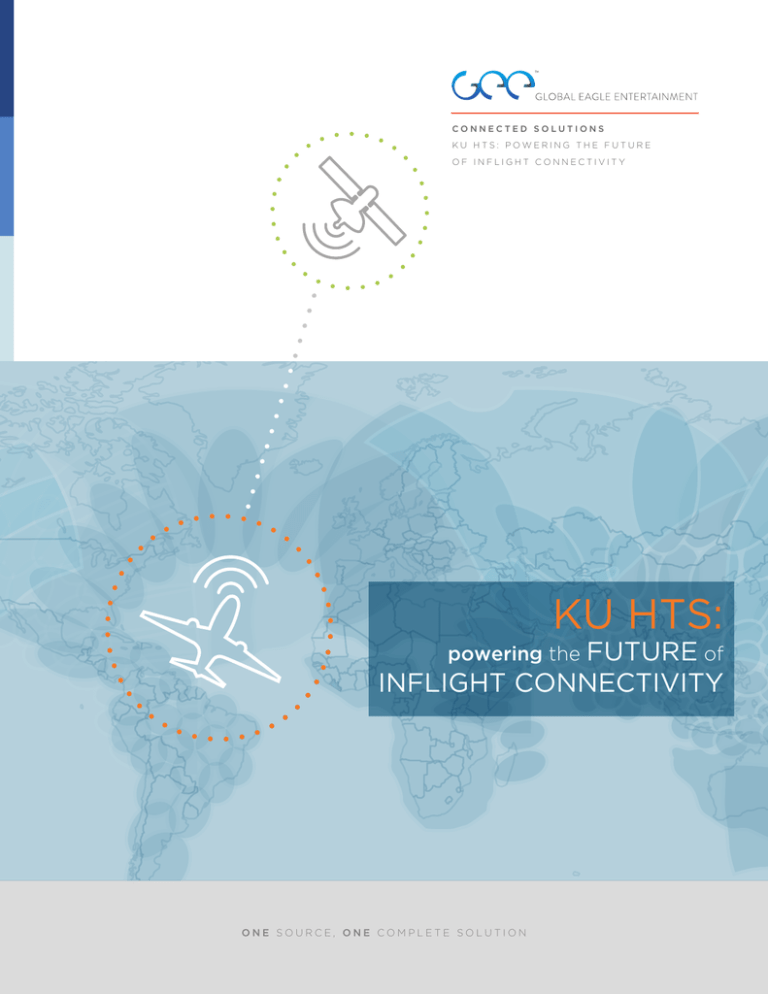
CONNECTED SOLUTIONS
KU HTS: POWERING THE FUTURE
OF INFLIGHT CONNECTIVITY
KU HTS:
FUTURE of
INFLIGHT CONNECTIVITY
powering the
ONE SOURCE, ONE COMPLETE SOLUTION
Ku HTS delivers 30gbps total throughput:
a reliably fast, robust, and global connectivity solution that delivers excellent
passenger experience and maximum opportunity for airline revenue.
Ka Regional HTS
Ku HTS
Ka Global
Ku Wide Beam
Ku and Planned Ku HTS Coverage
Stated Satellite capacity is not always a useful number as most
frequencies are reserved for Fixed Satellite Services (FSS)
Approximate and aggregate
from all suppliers.
Ka
Regional
HTS
90 GHz
BANDS
LICENSED
FREQUENCY
30 GHz
750 MHz
Ka
18 GHz
14.5 GHz
Ku HTS
30GHz
Ka
Global
3 GHz
30 GHz
Ku
Standard
Wide
1 GHz
14.5 GHz
FREQUENCY
PER BEAM
375 MHz
500 MHz
375 MHz
40
2 Pol
2 Freq
4 Color
1 GHz
500 MHz
750 MHz
36 MHz
80
Freq
1 GHz
36 MHz
750 MHz
750 MHz
Ku
10.7 GHz
60
2 Pol
2 Freq
4 Color
750 MHz
Ka
18 GHz
DIVERSITY
1 GHz
Ku
10.7 GHz
# BEAMS
1
2 Pol
1 GHz
1
1 GHz
2
BEAM S/N
Small
Beam
S/N
High
Med
Beam
S/N
High
Med
Beam
S/N
High
Large
Beam
S/N
Med
3
CAPACITY
PER BEAM
EFFICIENCY
FACTOR
COST
PER BIT
70%
$
2 bpHz
750 Mbps
In Route
3 bpHz
1.5 Gbps
Out Route
2 bpHz
750 Mbps
In Route
80%
$
3 bpHz
1.5 Gbps
Out Route
1.5 bpHz
54 Mbps
In Route
40%
$$
1.5 bpHz
54 Mbps
Out Route
1 bpHz
750 Mbps
In Route
95%
$$$
2 bpHz
1.5 Gbps
4
Out Route
5
1 This is the spectrum Licensed for Aero Mobile Satellite Services (AMSS) in the respective band (Ku/Ka)
2 Diversity applies when spot beams are adjacent to each other. Each adjacent spot beam has to have either opposite polarization or a different set of frequencies. Does
not apply to wide beam as there are no adjacent spots and the Polarity Doubles available spectrum
3 Smaller focussed beams have a better Signal to Noise ratio due to concentration of signal, larger beams have a lower s/n ratio due to signal spread over a large area
4 A Higher S/N ratio allows better encoding rates and a higher number of bits per hertz
5 Efficiency factor affects the cost of Space Segment. As the spot beams get smaller, the capacity in each beam has to be provisioned for the maximum number of aircraft
expected in that beam. This will happen for a very short time each day.
Ku Wide Area
LIVE TV SERVICE
and associated
advertising and
e-commerce
RELIABILITY
OF SERVICE
COVERAGE
BANDWIDTH
Ku HTS Spot
Yes
Yes
Limited
Limited
Uses Ku overlaid
wide beam for
economical support
of live TV
TV is expensive as it needs
to replicate transmission on
each beam, increasing the
cost by a factor
of +/- 50
TV is expensive as it needs
to replicate transmission on
each beam, increasing the
cost by a factor of +/- 50
Excellent
Excellent
Good
Good
Subject to rain
fade in extreme
weather only
Teleport diversity
resolves Ka downlink
susceptibility to
rain fade
Ka downlink and aircraft link
subject to rain fade.
Note that Ka downlink
can be geographically
positioned in dry areas, but
airline routes cannot
Ka downlink to ground
is subject to rain fade in
heavy weather
Strong
Can roam on Ku
or Ku HTS.
Limited
Global coverage
Worldwide coverage
using existing
satellites
HTS will cover high
traffic aviation
routes starting in
2015
Good
Excellent
Excellent
Good
Due to satellite
capacity, frequency
re-use, and high
power smaller
beams
Due to satellite capacity,
frequency re-use, and high
power smaller beams.
The bandwidth that may
actually be realized by any
inflight connectivity system
is more dependent upon
the throughput processing
power of the modem than
on the total bandwidth
available from any
single satellite.
But Satellite capacity
spread over global coverage
causes limited bandwidth
availability in high density
areas. GEE’s experience
in North America is that
airline customers currently
consume more than twice
the bandwidth than will
even be available in North
America using global Ka.
Low
Low
Low to Medium
Medium to High
There are multiple
operators,
meaning Ku HTS
networks will have
competitive pricing
opportunities
Sourced from a sole
operator, so monopoly
pricing power is in effect
Sourced from a sole
operator, so monopoly
pricing power is in effect
Yes
Maybe
Maybe
Limited cooling for HPT
and rain fade on ground;
Ka is adversely affected by
atmospheric moisture and
dirt, as well as high ground
temperatures.
But subject to rain fade on
ground; Ka is adversely
affected by atmospheric
moisture and
dirt, as well as high
ground temperatures
USE ON GROUND
i.e., gate-to-gate
service and delays
- includes use for
reporting functions
BACKUP
SYSTEM
COMPATIBILITY
across wide regions
of the world
REGULATORY
Regional coverage
(e.g., not available over the
Midwest US).
No international/
transoceanic coverage
But higher costs due
to overall satellite
capacity and RF
power spread over
larger area reduces
encoding rates
Yes
in case of Satellite
Failure
Ka Global
Wide beam is
economical and
can support 20+
channels across the
beam area
COST
MATURITY
Ka Regional HTS
Mature reliable
product
Leveraged from
mature
Ku systems
Limited installs in regional
areas (other than consumer
systems)
Still in development
Ku wide beam is
readily available
worldwide; multiple
sources provide
redundancy
Ku wide beam can
support areas if
Ku HTS satellites
become inoperable;
multiple sources
provide redundancy
No backup support available
Spare satellite can be moved
into position when launched,
date tbd
Yes
Yes
Yes
No
(private
infrastructure)
(private
infrastructure)
Different baseband
manufacturers/standards
at different regions
of the world
The rules on Ku are mature and well
understood - and the service has been
extensively field tested
The rules on Ka are in their infancy and subject to change
as more Ka satellites roll out
Comparative Scenario
Choosing a connectivity provider is a critical and complicated task that requires careful weighing of multiple features.
The scenarios following suggest real-life examples that address
Coverage: How do the services stack up across various geographical regions?
Bandwidth availability: How does this change based on location and/or acceptable market pricing?
Bandwidth actually used: What are the average statistics and usage patterns?
Passengers: What is the passenger experience?
Examples: 777-300 with 320 passengers, 20% of the passengers are streaming IPTV, 5% of the passengers
are streaming internet video, 10% are browsing the internet, and 5% are on social media
1
2015 - NYC to Sao Paulo
a) K
u/Ku HTS: the aircraft is receiving 20Mbps IPTV and 15Mbps data. Coverage
is 100%. The ideal scenario!
b) Ka Global: the aircraft is receiving no IPTV (as of Sept 2014. Sources claim 3 channels will be available in 2015) and 5Mbps
data. Limited streaming video. Coverage is 100%.
c) K
a Regional HTS: the aircraft is receiving 4Mbps IPTV (limited channels) and 15Mbps data. Coverage is 40% of flight route.
Also, the economic viability of live TV with this technology is poor
2
2015 - London to Dubai
a) K
u/Ku HTS: the aircraft is receiving 20Mbps IPTV and 15Mbps data. Coverage is 100% combined Ku and Ku HTS. Data
rates can still be maintained outside of Ku HTS coverage.
b) K
a Global: the aircraft is receiving no IPTV (as of Sept 2014. Sources claim 3 channels will be available in 2015) and 5Mbps
data. Limited streaming video. Coverage is 100%.
c) Ka Regional HTS: the aircraft is receiving 4Mbps IPTV (limited channels) and 15Mbps data. Coverage is 50% of flight route.
3
2015 - London to Shanghai
a) K
u/Ku HTS: the aircraft is receiving 20Mbps IPTV and 15Mbps data. Coverage is 100% combined Ku and Ku HTS. Data
rates can still be maintained outside of Ku HTS coverage.
b) K
a Global: the aircraft is receiving no IPTV (as of Sept 2014. Sources claim 3 channels will be available in 2015) and 5Mbps
data. Limited streaming video. Coverage is 100%.
c) Ka Regional HTS: the aircraft is receiving 4Mbps IPTV (limited channels) and 15Mbps data. Coverage is 20% of flight route.
Overview
Overview
As a global leader in inflight entertainment and connectivity – and with the most experience of any provider delivering satellitebased broadband – Global Eagle Entertainment is ideally positioned to share research on the features and relative benefits of
Ku band, Ku HTS, and Ka band satellite connectivity options. GEE is dedicated to helping their airline-partners achieve their
connectivity program goals – goals that lead to competitive advantages for the airline, including the development of profitable
services that improve the passengers’ experience.
As airline passengers become increasingly sophisticated and demanding vis a vis their expectations of technology and
entertainment provisions inflight, and as the use of handheld devices proliferates at an exponential rate, the need to provide
robust and economical connectivity becomes ever greater. New technologies are evolving rapidly to keep up with this demand.
Airlines across the globe expect their technological solutions to be state-of-the-art, flexible, and upgradeable – and that they can
adapt to the future demands of their passengers’ connectivity interests. As passenger needs grow and technology changes, the
system has to grow and change with them.
GEE endeavors to provide a meaningful comparison of inflight satellite technologies currently available – a comparison
that accurately addresses the
similarities and differences in:
•
•
•
•
•
C
overage
C
ost
C
apacity
C
apability
E
xperience
Many people in the inflight connectivity industry, including key decision-makers
at airlines throughout the globe, are under the impression that Ka Regional
HTS and global Ka will deliver bandwidth in excess of Ku HTS (high throughput
service). The information provided herein will support informed decisions about
investing in the technology that will appropriately – and cost-effectively – support
future requirements.
Global Eagle’s satellite-based service, via an established and
proven Ku band solution, is the superior choice. We anticipate
migration to Ku HTS in late 2015.
MARKET PERCEPTION
FACT
Ka Regional HTS
delivers greater
bandwidth to aircraft
than Ku HTS
The actual bandwidth delivered to an aircraft is almost identical between Ku HTS and Ka Regional HTS. The
regulatory bodies governing frequencies for Aeronautical Mobile Satellite Systems (AMSS) have allocated identical
bandwidth for Ku and Ka systems. Additionally, Ku HTS and Ka Regional HTS systems use identical modem
technology as both space segment frequencies are converted to identical L-band or baseband frequencies.
Ka Regional HTS
can deliver all of the
service Ku HTS and Ku
can deliver
Due to bandwidth and price constraints, Ka Regional HTS cannot, in fact, deliver streaming (live) TV across almost
one-third of the global airline industry’s flight routes. Even in regional routes, Ka Regional HTS may not provide
100% coverage (their coverage targets highly populated areas).
In addition, Ka band is more susceptible to atmospheric and ground heat interference. As a result, airlines will not
be able to consistently and reliably offer gate-to-gate service.
Both scenarios reduce the airlines’ revenue opportunities and “passenger satisfaction index.”
Ka Regional HTS is less
expensive than Ku HTS
Ka Regional HTS can
offer continuity in
service delivery
Air-to-Ground
technology is
satisfactory as long
as the aircraft remains
over land
While some Ka Regional HTS satellites have a larger overall capacity due to smaller beam size and Fixed Operator
Use, in reality it is not possible to sell all bandwidth in all cells as the high traffic regions will sell out first. Selling
out one cell will cause an outage in a mobile environment.
Furthermore, the primary market for Ka HTS operators is consumer home satellite-based Internet, and due to lack
of suppliers offering a competitive environment there is no motivation to reduce costs for aero customers. On the
other hand, Ku HTS satellite operators compete with Ku and Ka HTS services, creating competition between the
various operators that in turn drives down prices.
Because Ka Regional HTS operates on different satellites that require different protocols (i.e., “languages”), they
are not necessarily compatible and transition issues arise.
Ku HTS is globally available in a uniform manner and allows an airline to provide service everywhere, seamlessly.
Ku HTS also allows for seamless transitions from spot to wide beam, on the same flight, with the same hardware.
Ka Regional HTS cannot make these transitions, as would be necessary on an international flight.
Airlines frequently change routes to adapt to seasonal loads, future opportunities, natural disasters, and political
events. If an airline cannot deliver the same consistent service in each aircraft, regardless of where they fly, the
airline will be unable to effectively market (i.e., capitalize upon) the service to passengers and will be unable to
shape passenger expectations. Additionally, ATG service and scalability outside the US and across international
borders suffers from issues with network compatibilities and roaming agreements.
Competitive Advantage
GEE’s experience includes
• the successful installation and support of more than 568 aircraft flying 3200 flights per day
• the ability to offer gate-to-gate service – improving passenger experience AND airline productivity
• the fastest broadband satellite system retrofit time in the industry
• the world’s only web based commercial and technical reporting solution available to airlines
• a digital rights management (DRM) solution certified by Hollywood studios
• managing government (STC) approvals throughout North America and the world
• maintaining the equipment and training local airline teams
• the ability to send and receive data reports inflight and on-the-ground, regardless of weather
• the world’s only ITP – Intelligent Traffic Prioritization Engine – which prioritizes and channels bandwidth demands
on-the-go for superior passenger experience
• the market leading IFE, content, and service provider with the world’s largest market share of entertainment content
Critical Questions
Global Eagle Entertainment has earned a reputation as a credible resource for satellite connectivity, capabilities research, and
long-term support. Our goal is to provide our airline clients with the latest and most robust information and service. GEE’s
proven track record provides an ideal business model of an effective Ku-based satellite program, a program that offers an
inherently wider range of capabilities when compared to Ka band.
Before making your decision to install a satellite-based technology solution you need the best answers to the right questions.
Ask your connectivity suppliers these questions:
• What does satellite capacity actually mean to you, the airline, and to the passengers’ experience inflight? What will
a passenger actually experience on a flight equipped with your system?
• What inflight connectivity services and products will you provide across all of the airlines’ routes?
• What does bandwidth mean to the airline and the passenger?
• What is the difference between the aggregate bandwidth the satellite is capable of delivering, and the actual Mbps
delivered to a single passenger device?
• How quickly would an average movie / webpage / song load, given the bandwidth provided, the bandwidth usable,
the capabilities of the modem, and your passengers’ average usage statistics?
• Stated another way, What is the relationship between the satellite’s potential output vs the onboard modem’s
capacity vs what passengers actually consume?
• What is the relative price of the service - relative to the services offered by Ku-HTS, for example?
• What content services can you provide? What can’t you provide?
• How will you adapt your coverage range when a flight route changes? How quickly can this
coverage adapt?
• Will you be able to deliver the same IFC services over these new routes?
• What is your long-term financial model?
• What are the coverage limitations to your solution?
• What proven expertise does your organization have helping an airline generate
revenue and develop new passenger solutions?
GEE, Global Eagle Entertainment | 4553 Glencoe Avenue | Marina Del Rey, CA 90292 | www.globaleagleent.com
© copyright 2014, Global Eagle Entertainment Inc. All rights reserved.





